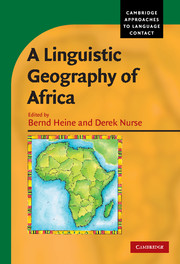Book contents
- Frontmatter
- Contents
- List of maps
- List of figures
- List of tables
- List of contributors
- Series editor's foreword
- Acknowledgments
- Abbreviations
- 1 Introduction
- 2 Is Africa a linguistic area?
- 3 Africa as a phonological area
- 4 Africa as a morphosyntactic area
- 5 The Macro-Sudan belt: towards identifying a linguistic area in northern sub-Saharan Africa
- 6 The Tanzanian Rift Valley area
- 7 Ethiopia
- 8 The marked-nominative languages of eastern Africa
- 9 Africa's verb-final languages
- Notes
- References
- Index
9 - Africa's verb-final languages
Published online by Cambridge University Press: 22 September 2009
- Frontmatter
- Contents
- List of maps
- List of figures
- List of tables
- List of contributors
- Series editor's foreword
- Acknowledgments
- Abbreviations
- 1 Introduction
- 2 Is Africa a linguistic area?
- 3 Africa as a phonological area
- 4 Africa as a morphosyntactic area
- 5 The Macro-Sudan belt: towards identifying a linguistic area in northern sub-Saharan Africa
- 6 The Tanzanian Rift Valley area
- 7 Ethiopia
- 8 The marked-nominative languages of eastern Africa
- 9 Africa's verb-final languages
- Notes
- References
- Index
Summary
The verb-final type in a crosslinguistic perspective
The position of the verb relative to other constituents within a clause has been claimed by a number of authors to be a predictor of an additional set of syntactic features. Thus, according to Greenberg (1966), verb-initial languages tend to be prepositional rather than postpositional, putting inflected auxiliary verbs before rather than after the main verb; with more than chance frequency, verb-final languages tend to use postpositions, with auxiliary verbs following the main verb. Such inductively based generalizations about the nature of language of course require further analyses and explanations, e.g. in terms of preferred parsing or processing structures for the human mind.
In more recent correlative studies of this type, e.g. by Dryer (1992), a distinction is drawn between phrasal and non-phrasal elements. Whereas phrasal elements, such as subject and object phrases or adpositions appear to follow a more consistent right-branching or left-branching pattern crosslinguistically, the position of non-phrasal categories such as adjectives, demonstratives, negative particles, or tense–aspect markers does not seem to correlate with constituent order type, as argued by Dryer.
Obviously, constituent order is but one of various factors determining the typological portrait of a language, morphological techniques used in expressing syntactic and semantic relations being another important parameter. This latter observation of course is not new; Sapir (1921:120–46) already pointed out that languages may differ considerably in the techniques used for the expression of syntactic relations.
- Type
- Chapter
- Information
- A Linguistic Geography of Africa , pp. 272 - 308Publisher: Cambridge University PressPrint publication year: 2007
- 1
- Cited by

